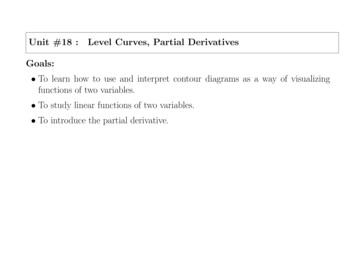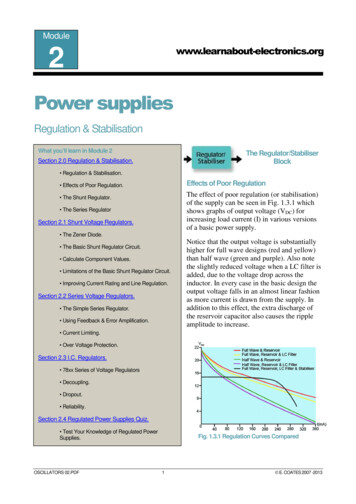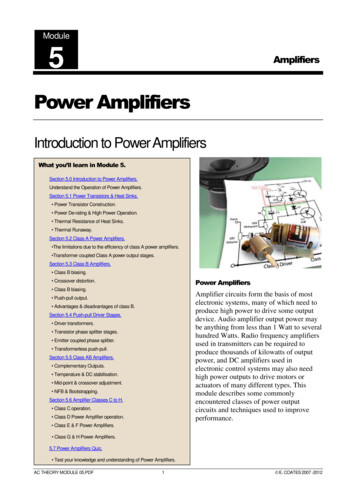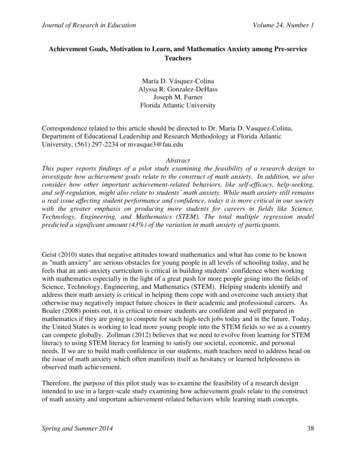
Transcription
Unit #18 :Level Curves, Partial DerivativesGoals: To learn how to use and interpret contour diagrams as a way of visualizingfunctions of two variables. To study linear functions of two variables. To introduce the partial derivative.
Graphs of Surfaces and Contour Diagrams - 1Picturing f (x, y): Contour Diagrams (Level Curves)We saw earlier how to sketch surfaces in three dimensions. However, this is notalways easy to do, or to interpret. A contour diagram is a second option forpicturing a function of two variables.Suppose a function h(x, y) gives the height above sea level at the point (x, y) on amap. Then, the graph of h would resemble the actual landscape.
Graphs of Surfaces and Contour Diagrams - 2Suppose the function h looks like this:Then, the contour diagram of the function h is a picture in the (x, y)–planeshowing the contours, or level curves, connecting all the points at which h hasthe same value. Thus, the equationh(x, y) 100gives all the points where the function value is 100.
Graphs of Surfaces and Contour Diagrams - 3Together they usually constitute a curve or a set of curves called the contour orlevel curve for that value. In principle, there is a contour through every point. Inpractice, just a few of them are shown.The following is the contour diagram for the earlier surface.32264264840100 22220 6 20 4 2 20 2 4 10 3 320 22 2 10123Indicate the location of the peaks and pits/valleys on the contour diagram.
Graphs of Surfaces and Contour Diagrams - 4Topographic maps are also contour maps.Identify first a steep path, and then a more flat path, from the town up toSignal hill.
Graphs of Surfaces and Contour Diagrams - 5In principle, the contour diagram and the graph can each be reconstructed fromthe other. Here is a picture illustrating this:As shown above, the contour f (x, y) k is obtained by intersecting the graph of fwith the horizontal plane, z k, and then dropping (or raising) the resulting curveto the (x, y)–plane. The graph is obtained by raising (or dropping) the contourf (x, y) k to the level z k.
Interpreting Contour Diagrams - 1Interpreting Contour DiagramsMatch each of the following functions to their corresponding contour diagram.(1) h(x, y) is the degree of pleasureyou get from a cup of coffeewhen- x is the temperature, and- y is the amount of ground coffee used to brew it.(2) f (x, y) is the number of TV setssold when- x is the price per TV set, and- y is the amount of moneyspent weekly on advertising.(3) g(x, y) is the amount of gas perweek sold by a gas station when- x is the amount spent onbonus gifts to customers, and- y is the price charged by anearby competitor.
Interpreting Contour Diagrams - 8009008000700600800900700070050600070000204020030
Interpreting Contour Plots - Examples - 1Useful Properties of Contour PlotsIf the contour lines are evenly spaced in their z values, contour lines closer together indicate more rapid change/steeper slopes. contour lines further apart indicate flatter regions. peaks and valleys look the same; only the values of the contours let youdistinguish them.
Interpreting Contour Plots - Examples - 2ExampleDraw the contours of f (x, y) (x y)2 for the values f 1, 2, 3, and 4.y21x 21 1 1 22
Interpreting Contour Plots - Examples - 3Give a verbal description of the surface defined by f (x, y) (x y)2.
Interpreting Contour Plots - Examples - 4Here is the function f (x, y) (x y)2 plotted as a surface.
Interpreting Contour Plots - Examples - 5Example: Draw the contours of f (x, y) x2 y 2 for the values1, 2, 3, and 4.y21x 21 1 1 22
Interpreting Contour Plots - Examples - 6From the contour diagram, is the value of f at (0, 0) a local minimum ormaximum?Is the surface becoming more or less steep as you move away from the origin?Try to associate how the lines on the contour diagram could help you to imaginethe actual surface:
Linear Functions of Two Variables - 1Linear Functions of Two VariablesA function of two variables is linear if its formula has the formf (x, y) c mx ny.The textbook shows that m and n can be interpreted as slopes in the xdirection and the y-direction, respectively, and that c is the z-intercept.Consider the plane z 2 x y. This plane has slope -1 in both the x- andthe y-directions. Is there any direction in which it has a steeper slope?It may help to experiment by holding up a book or other flat object.
Linear Functions of Two Variables - 2Linear ExampleGiven that the following is a table of values for a linear function, f , completethe table.x21.1 2345y 1.21.3211.4 8Give a formula for the function f (x, y) in the preceding example.
Linear Functions of Two Variables - 3Sketch contours of the linear function f .Based on this example, hypothesize properties of the contour diagrams for alllinear functions.
Partial Derivatives - 1Partial Derivativesdfis the rate of change of f (x) when x is changed, so the derivatives ofJust asdxf (x, y) are the rates of change of the function value when one of the variables ischanged. Since there are two variables to choose from, there are two derivatives,one to describe what happens when you change x only and one to describe whathappens when you change y only. Because either derivative by itself describes thebehaviour of the function only partly, they are called partial derivatives.
Partial Derivatives - 2If we look at a graph of z f (x, y), partial derivatives tell us how the height ofthe graph, z, is changing as the point (x, y, 0) moves along a line parallel to thex-axis or parallel to the y-axis.(x0, y0, 0) (x0 h, y0, 0) (along solid line parallel to the x-axis).(x0, y0, 0) (x0, y0 h, 0) (along dotted line parallel to the y-axis).
Partial Derivatives - 3Definition of Partial Derivatives ff (x0 h, y0) f (x0, y0)(x0, y0) limh 0 xh fx(x0, y0) ff (x0, y0 h) f (x0, y0)(x0, y0) limh 0 yh fy (x0, y0)As a shorthand, f fx(x0, y0) also means the same as(x0, y0), and x f fy (x0, y0) also means the same as(x0, y0). yThere is no f 0(x, y) notation possible when working with multivariate functions.
Partial Derivatives - 4 fTo actually calculatewhen we have a formula for f (x, y), we imagine that y xis fixed, then we have a function of only one variable and we take its derivative in f, we imagine that x is fixed and y is not.the usual way. To calculate y
Partial Derivatives - 5Example: Consider f (x, y) x2y sin(xy).Write a new single-variable function: g(x) f (x, y0)Finddg.dx
Partial Derivatives - 6 fMore practically, when we are looking for(x, y) — a formula in terms of xx and y — we do not actually replace y by y0, but simply think of it as a constant.f (x, y) x2y sin(xy) f(x, y).Find xFind f(x, y). y
Partial Derivative Practice - 1Partial Derivative PracticeExample: Find both partial derivatives for f (x, y) (1 x3)y 2.
Partial Derivative Practice - 2Example: Find both partial derivatives for f (x, y) ex sin(y).
Partial Derivative Practice - 3x2Example: Find both partial derivatives for f (x, y) .4y
Partial Derivative Practice - 4 22Question:x tan(y) y x is y(a) 2x sec2(y) 2y 1(b) x2 sec2(y) 2y(c) 2x tan(y) 1(d) x2 tan(y) y 2 1
Partial Derivative Practice - 52Example: Consider f (x, y) x2 sin y exy . f(1, 0).Find the value of x fFind the value of(1, 0). y
Partial Derivative Practice - 6What do these values partial derivative values tell you about the graph of2f (x, y) x2 sin y exy near (1, 0)?
Partial Derivatives - Economics - 1Partial Derivatives - Economics g g(x, y) and(x, y) ifExample: What are the signs of x y g(x, y) is the amount of gas sold per week by a gas station, x is the station’s price for gas, and y is the price charged by a nearby competitor?(a) g gandare both positive. x y g gis positive,is negative.(b) x y(c) g gis negative,is positive. x y g g(d)andare both negative. x y
Partial Derivatives - Economics - 2Example: h hWhat would you expect the signs of(x, y) and(x, y) to be x yif h(x, y) is the number of pairs of ski lift tickets sold in a year in Canada, x is the number of ski boots sold, and y is the number of tickets from Canada to warmer vacation spots. h h(a)andare both positive. x y(b) h his positive,is negative. x y h h(c)is negative,is positive. x y h handare both negative. x yEconomics key words: substitutes and complements.(d)
Partial Derivatives - Ideal Gas Law - 1Partial Derivatives - Ideal Gas LawRecall the ideal gas law, written with pressure as a function of temperature andvolume:nRTP (V, T ) VFor one mole of gas (n 1) and the SI units of kPa, liters and degrees Kelvin, P Pfindand. Give the units of both derivatives. T V
Partial Derivatives - Ideal Gas Law - 2Evaluate both derivatives at T 300o K and V 10 liters. Use R 8.31 LkPa /(K mol)
Partial Derivatives - Ideal Gas Law - 3Express the meaning of both PT (10 L, 300o K) and PV (10 L, 300o K) in words.
Partial Derivatives from Contour Diagrams - 1Partial Derivatives from Contour DiagramsExample: Consider the contour diagram shown below, representing thefunction h(x, y). hQuestion:(1, 1) is x(a) positive(b) negative(c) zero hQuestion:(1, 1) is y(a) positive(b) negative(c) zero
Partial Derivatives from Contour Diagrams - 2 hQuestion:at the point B is x(a) positiveQuestion:(a) positive(b) negative(c) zero(b) negative(c) zero hat the point B is y
Partial Derivatives from Contour Diagrams - 3 hseems particularlyOn the same contour diagram, mark a point where xlarge.
Partial Derivatives from Table Data - 1Partial Derivatives from Table DataGiven the following table of values for f (x, y), calculate approximate val f f(1, 1) and(1, 1). (Multiple answers are possible, because we areues for x yestimating.)x0.9y 1.14.445.998.0810.911.23.534.756.428.67
Partial Derivatives from Table Data - 2What do the values fx(1, 1) and fy (1, 1) tell you about the graph of f (x, y) near(1, 1)?
- x is the price per TV set, and - y is the amount of money spent weekly on advertising. (3) g(x;y) is the amount of gas per week sold by a gas station when - x is the amount spent on bonus gifts to customers, and - y is t











